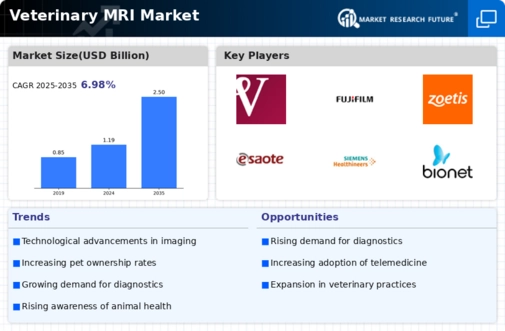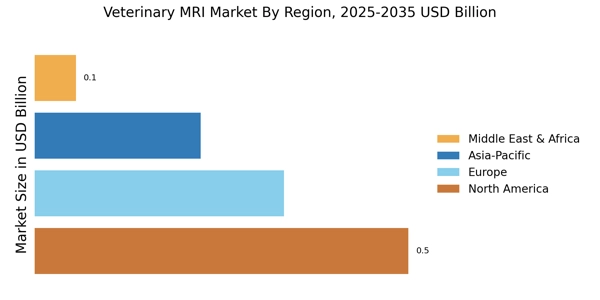Focus on Preventive Care
The Veterinary MRI Market is witnessing a notable shift towards preventive care in veterinary medicine. As awareness of the importance of early diagnosis grows, veterinarians are increasingly utilizing MRI technology to identify potential health issues before they escalate. This proactive approach not only enhances the quality of care but also reduces long-term treatment costs for pet owners. The emphasis on preventive care is reflected in the rising number of veterinary visits, with many pet owners opting for regular check-ups that include advanced imaging. This trend indicates a growing acceptance of MRI as a standard diagnostic tool in veterinary practices, thereby driving demand within the Veterinary MRI Market.
Increasing Pet Ownership
The Veterinary MRI Market is significantly influenced by the rising trend of pet ownership. As more households adopt pets, the demand for veterinary services, including advanced imaging techniques, is likely to grow. According to recent statistics, pet ownership rates have reached unprecedented levels, with millions of households now considering pets as integral family members. This shift in perception has led to increased spending on pet healthcare, including diagnostic imaging. Consequently, veterinary practices are investing in MRI technology to meet the growing needs of pet owners seeking comprehensive care for their animals. This trend suggests a robust market potential for veterinary MRI systems, as pet owners increasingly prioritize advanced medical care for their pets.
Expansion of Veterinary Practices
The Veterinary MRI Market is benefiting from the expansion of veterinary practices and specialty clinics that offer advanced diagnostic services. As the number of veterinary facilities increases, so does the competition, prompting clinics to invest in cutting-edge technologies, including MRI systems. This expansion is particularly evident in urban areas, where pet owners are seeking specialized care for their animals. Additionally, the establishment of referral practices that focus on advanced imaging is likely to drive demand for veterinary MRI services. The trend towards specialization in veterinary medicine indicates a growing recognition of the value of MRI in diagnosing complex cases, thereby enhancing the overall market landscape for veterinary MRI technology.
Rising Incidence of Animal Diseases
The Veterinary MRI Market is also propelled by the increasing incidence of various animal diseases, particularly those affecting the neurological and musculoskeletal systems. Conditions such as tumors, spinal disorders, and joint diseases are becoming more prevalent, necessitating advanced diagnostic tools like MRI for accurate assessment and treatment planning. The growing awareness among pet owners regarding these health issues is leading to higher veterinary consultations and imaging requests. Furthermore, the rise in chronic diseases among pets is prompting veterinary clinics to adopt MRI technology as a standard diagnostic procedure. This trend suggests a sustained demand for veterinary MRI systems, as practitioners seek to provide comprehensive care for affected animals.
Technological Advancements in Imaging
The Veterinary MRI Market is experiencing a surge in technological advancements that enhance imaging capabilities. Innovations such as high-field MRI systems and advanced software algorithms improve diagnostic accuracy and efficiency. These advancements allow veterinarians to obtain clearer images, facilitating better treatment decisions. The integration of artificial intelligence in image analysis is also gaining traction, potentially reducing the time required for diagnosis. As a result, the demand for state-of-the-art MRI systems is likely to increase, driving market growth. Furthermore, the introduction of portable MRI units may expand access to veterinary imaging services, particularly in rural areas. This trend indicates a shift towards more sophisticated imaging solutions, which could reshape the landscape of the Veterinary MRI Market.


















Leave a Comment